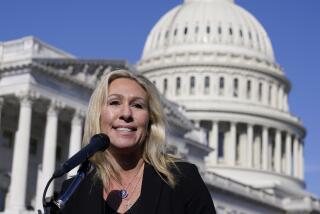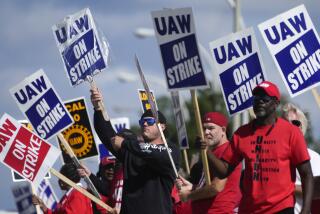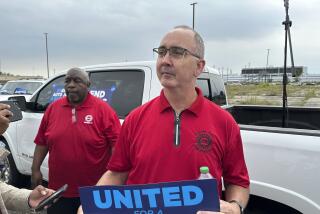Bailouts: too big a crutch?
How far will the bailout binge go?
So far this year, the federal government has put up nearly $30 billion to avert a major financial default by the investment bank Bear Stearns Cos.; committed to investing as much as $200 billion in preferred stock of the loss-plagued finance giants Fannie Mae and Freddie Mac and at least $5 billion in their mortgage securities; and agreed to provide an emergency loan of $85 billion to American International Group Inc. in return for an ownership stake of as much as 80% in the stricken insurance giant.
Tuesday’s helping hand to AIG bailed out not only that company, which was contemplating a bankruptcy filing as early as today, but also countless trading partners of the firm, including investment banks that had failed to raise the massive loans themselves.
Thus far, only one major supplicant for federal assistance has been turned away: investment bank Lehman Bros. Holdings Inc., which was refused a bailout by Treasury Secretary Henry M. Paulson Jr. last weekend and filed for bankruptcy protection Monday. Meanwhile, Congress is contemplating a loan program of $25 billion to $50 billion for automakers.
This year’s bailouts add up to an unprecedented surge of direct financial intervention by the government in the nation’s private sector -- a cornucopia of handouts and guarantees dwarfing the rescue of the savings and loan industry in the 1980s, which ended up costing taxpayers some $124 billion.
In each case, industry and government officials have justified the bailout as cheaper in the long run than doing nothing. But critics contend that bailouts often encourage bad behavior by relieving underperforming industries of the consequences of their ineptitude.
In addition, sometimes the government can end up as an investor in companies that are the target of regulatory action, creating a conflict of interest. The government’s potential ownership of AIG could put policymakers at cross-purposes with their own efforts to regulate a variety of financial transactions in which the company participates.
The situation is bound to raise thorny policy issues for the next president, who is likely to face further demands for assistance from mortgage lenders, home builders, automakers and other struggling industries. Economic and legal experts say Congress and regulators need a set of standards for how to treat industries and companies with their hands out, especially when the requests come in an atmosphere of crisis.
“The more the government steps in, the more there are people who want the government to step in,” says Peter J. Wallison, a research fellow at the American Enterprise Institute and a former White House and Treasury Department official. “Every time you do it, that creates an equitable argument for someone else to get bailed out.”
The president and Congress will also have to decide what sort of concessions to demand from recipients of public largess. For example, only days after the Treasury Department announced the Fannie Mae and Freddie Mac bailout this month, several Senate Democrats proposed that the mortgage companies freeze foreclosures for at least 90 days.
A loan guarantee package for the auto industry is likely to be one of the most closely watched measures in Congress this year. U.S. automakers contend that financial help is warranted because the cost of redesigning their products to meet federally mandated mileage standards by a 2020 deadline will be staggering.
That could provide a template for a similar appeal from airlines, which could argue that the costs of fuel and security measures are hobbling them.
Without more open rules governing the decision-making process, the entities with the most potent lobbyists may get bailouts, putting competitors at a disadvantage.
“We don’t have any rules about whether the government should get involved or not,” says Cheryl Block, a law professor at Washington University in St. Louis who has followed the bailout issue since the 1990s. “Certain things happen in the middle of the night, and no one knows who’s in the meeting.”
For now, the decisions seem to be based on a sense that an entity is “too big to fail.”
Such concerns drove the bailout of Fannie Mae and Freddie Mac, which together back half of all U.S. residential mortgages. Their failure, government officials feared, could choke off the supply of mortgage credit or drive up mortgage interest rates to levels that would impede recovery for the country’s beleaguered housing market.
“Fannie and Freddie define what’s ‘too big to fail,’ ” says Jared Bernstein, an economist at the Economic Policy Institute.
A similar case could be made for a company such as General Motors Corp. More than 250,000 workers and roughly 500,000 retirees worldwide are dependent to some degree on the survival of GM; a bankruptcy filing would throw many workers on the street and could deprive thousands of families of health coverage. It also could further strain the federal Pension Benefit Guaranty Corp., which insures retirement benefits and already has a $13-billion deficit.
But a company need not be the biggest in its industry to pass the “too big to fail” test. Bear Stearns was the nation’s fifth-ranked investment bank in terms of assets when the Federal Reserve and the Treasury arranged its emergency sale to JPMorgan Chase & Co. in March. Bear Stearns’ deal-making, though, extended deeply into the financial derivatives markets, raising fears that its sudden collapse would produce a tidal wave of defaults around the globe, shattering the confidence necessary to keep the international credit markets functioning smoothly.
The interventions surrounding Bear Stearns and Fannie/Freddie suggest that government officials have been fairly successful at distinguishing cases in which a company’s failure would have broad “systemic risk,” and acting only in those cases, says Laurent Jacque, professor of international finance and banking at Tufts University.
Still, some economists believe that the “too big to fail” standard, if too loosely applied, can lead to imprudent risk-taking by big companies.
“To the extent that creditors of TBTF banks expect government protection, they reduce their vigilance in monitoring . . . these banks’ activities,” wrote Gary H. Stern and Ron Feldman, two high-ranking Fed officials, in 2004.
“The case could be made that there’s a shift on the part of the political establishment in favor of bailouts,” says Robert Bliss, a former senior financial economist at the Federal Reserve Bank of Chicago who is now a business professor at Wake Forest University.
Presidential politics may be driving the recent rush toward government assistance. In June, Republican candidate Sen. John McCain drew a line against the auto industry bailouts during an appearance in Ohio, saying, “I just don’t see a scenario where the federal government would come in and bail out any industry in America today.”
As Michigan’s importance as a swing state in the presidential race grew, however, McCain changed his tune. In August he proclaimed, “We should fund [the loan program] and take action that will assist Detroit and its suppliers in making it through this difficult time of transition.”
Democratic nominee Sen. Barack Obama also supports the auto loans.
Bailouts have long been a part, albeit a controversial one, of U.S. policymaking.
In 1971, the government bailed out Lockheed Aircraft Co., which was then the third-largest commercial aircraft manufacturer but the nation’s largest military contractor, with $250 million in loan guarantees. In 1979, Congress provided loan guarantees of as much as $1.5 billion for ailing Chrysler Corp., the No. 3-ranked U.S. automaker. After the Sept. 11, 2001, terrorist attacks the airlines received $5 billion in cash and $10 billion in loan guarantees to tide them over the slump in air travel.
Some experts fear that government investments in the open market could artificially support market prices, thus creating a “moral hazard” that investors will make unduly risky choices, assuming that government intervention will limit their losses.
That’s a concern presented by the Treasury’s plan to buy mortgage-backed securities issued by Fannie Mae and Freddie Mac and take a large stake in AIG.
“They’re essentially saying they’re going to put a floor under the market,” says John Lapp, a professor of economics at North Carolina State University. “That’s just begging for excessive risk-taking.”
Others say that bailouts can be good medicine for ailing industries, particularly when they’re coupled with strong incentives to improve. It is widely assumed in Washington that the financial-industry bailouts will lead to tighter regulation of investment banks.
On occasion, the government may turn a profit on a bailout. Chrysler’s recovery netted Uncle Sam about $300 million.
In any case, the bailout debate may help focus Americans on what industrial policies are proper for today’s world.
“It doesn’t take a genius to see that the auto industry has had a very bad time,” economist Bernstein says. “Now we can all get together and decide whether we want an auto industry, and what kind.”
Demands for government help will probably never go away, he adds. Loosely paraphrasing the opening line of Leo Tolstoy’s “Anna Karenina,” he observes: “All happy companies are alike, but every unhappy one wants a bailout.”
--
More to Read
Inside the business of entertainment
The Wide Shot brings you news, analysis and insights on everything from streaming wars to production — and what it all means for the future.
You may occasionally receive promotional content from the Los Angeles Times.










